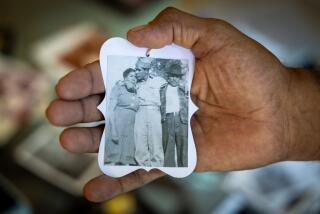Cemetery sleuths won’t rest
You’d expect some weird things in Candace Wheeler’s work space, since she helps manage burial grounds near the former Comstock Lode, and the 120-pound sleeping cherub on her filing cabinet certainly fit the bill.
Someone had swiped it from a Virginia City cemetery decades ago. A woman rediscovered it while cleaning her grandfather’s garage and brought it to the Comstock History Center.
“It doesn’t even faze you, not up here,” Wheeler said of the curious donation. Stuff plundered from the Comstock cemeteries has a way of boomeranging back.
Since the mid-1990s, more than 100 stolen headstones, flower holders and fence posts have returned to Virginia City, many with notes that essentially say, “I stole this, it cursed me, take it back! (P.S. Here’s my number. Call when it’s in the graveyard. Then I can sleep again.)”
Once beautiful Victorian gardens, the Comstock’s resting places had fallen into such disrepair over the years that they had invited a pillager’s free-for-all, leaving it to Wheeler and other cemetery boosters to reunite the stolen artifacts with the proper graves.
It’s not easy. The cemetery preservationists often have few photographs or clues to guide them. Maybe they’d have more luck with the sleeping cherub.
Graves of yore
Virginia City, Nev., boomed in the 1860s as a silver mining town, where, at first, drinkable water meant adding whiskey. Corpses were buried where convenient and, if mining demanded it, were uprooted, Wheeler wrote in “The Comstock Cemeteries: Changing Landscapes of Death,” her master’s thesis at the University of Nevada, Reno.
In 1867, fraternal and religious groups began carving out the elaborate Silver Terrace cemetery complex in Virginia City. The Masons’ pathway curved like a trowel. Anchoring the Catholic section: a 40-foot cross. There were granite walls, roses and lilacs, white fences, orange trees and a full-time caretaker -- reflecting, Wheeler said, Virginia City’s transformation from shoddy to stylish.
But when the boom waned -- and the population fell from 30,000 to a few hundred -- the Comstock’s burial grounds resembled an heiress stripped of her jewels.
Wheeler started asking around: Why were the cemeteries ailing? (Too many stakeholders. Too little money. Lots of squabbling.) So, in 2000, she and others founded the nonprofit Comstock Cemetery Foundation, which co-manages about 65 acres of cemeteries.
One afternoon, the sun fading, volunteer Cal Dillon paused in the cemetery at Gold Hill, a town south of Virginia City, to note what’s arguably the group’s best-known headstone.
The deaths of the Jones brothers on Christmas Eve 1871 were part of Comstock lore: At their father’s insistence, the boys were rounding up cows when a fierce blizzard struck.
Their grave marker was stolen, but Dillon used photos a hiker took in the 1960s to replicate the original’s font and feel. Visitors now leave dozens of toys: water guns, fire trucks, a train engine. Dillon cracked a smile.
Years ago, his wife, Alexis, had offered to research Gold Hill. A stone mason, Dillon soon pitched in. He’s now supervised the repairs of some 300 headstones. “I felt I was trying to save something instead of watching it disappear,” he said.
He glanced across the graveyard at a headstone with a checkered history.
The marker for Mary Neville, who died in 1872, was, at one point, stolen. It inexplicably ended up at the Storey County courthouse. Officials gave the 400-pound marble slab to Wheeler; no one was sure where it belonged.
One morning in 2008, Bert Bedeau, the Comstock History Center director, pulled out two dozen photos of Gold Hill. Then he spotted it: “It was Mary Neville’s stone. In the cemetery. Before it was stolen!”
Dillon and Wheeler tromped around Gold Hill for two days, comparing the landscape and the photos. They found the burial site using a distinctive mark on a nearby hill. The headstone’s official return was written up jubilantly in local papers, though the marker described a particularly wrenching death:
Affliction sore long time she bore;
Physicians’ skill was vain.
Till God did please death her to cease
And ease her of her pain.
The ‘curse’
Why steal from a cemetery?
Wheeler was confronted with the question when she found a package in the middle of Silver Terrace’s Masonic burial grounds. Inside: a partial granite pillar and a note.
“I stole this about 20 years ago and I’ve been using it as a door stop. I blame it for my divorce and need you to put it back.”
A few years later, Wheeler decided to call the people who’d returned pilfered stuff. Thirty-three agreed to be interviewed, on the condition of anonymity. Back home, thieves used the plunder as garden art, firewood, patio pavers -- until misfortune hit them.
“They cited examples of ‘bad luck’ that ranged from sickness and death to divorce. They sought a firm promise . . . that it would be placed in its ‘rightful location.’ This was thought to ‘reverse the curse,’ ” Wheeler wrote in her thesis. No one volunteered that their misfortune had abated, though Wheeler didn’t ask.
Once the cemeteries got fences in 2004, vandalism plummeted more than 80%. In 2005, the cemetery group notched another victory when the Nevada Legislature raised cemetery vandalism from a misdemeanor to a low-level felony.
These days, the cemeteries are more parks for the living than monuments to the dead, with about 100 visitors a day -- sometimes led by tour guides in period costumes -- and more marriages than funerals.
Storey County officials once considered locking the cemeteries at dusk, in hopes of preventing vandalism. At a public meeting, one woman said the townsfolk would never acquiesce. Too many of them, she said, fondly remembered downing beers or losing their virginity on cemetery grounds.
The discussion abruptly ended.
‘Tell me I’m right!’
One afternoon, Wheeler and Dillon drove the marble cherub from the history center to Silver Terrace. Headstones were sunken and fencing askew, as though someone had given the hills a good shake.
Dillon lugged the cherub into the cemetery. Wheeler’s teenage son had guessed it belonged to the grave of Lewis Horace Osbiston, who was 1 month old when he died in 1874. The baby’s resting place was near the cemetery entrance, giving the cherub smugglers an easy getaway.
“Come on, tell me I’m right! Tell me I am right!” Wheeler called to Dillon.
He placed the cherub on the massive grave marker. He leaned in. On the left side, the cherub and the base were similarly chipped. He thumbed the marble. Both cherub and base had equally “sugared,” or deteriorated to something rough and granular.
He turned toward Wheeler, smiling. She wrapped him in a hug. When they returned to the history center, she greeted Bedeau by exclaiming: “My cherub found a home!”
ashley.powers@ latimes.com


